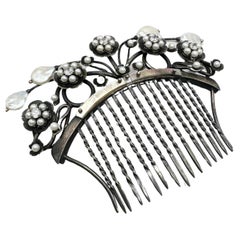Hair Accesories
21st Century and Contemporary Models and Miniatures
Pearl, Silver
People Also Browsed
Antique 1810s Vanity Items
Silver, Gilt Metal
Antique 1810s French Empire Vanity Items
Silver, Brass
Antique Late 19th Century British Enamel Frames and Objects
White Diamond, 18k Gold, Silver
Vintage 1960s French Retro Drop Necklaces
Diamond, Sapphire, Platinum
Antique Early 1900s French Edwardian Vanity Items
Diamond, Gold, 18k Gold, Yellow Gold, Platinum, Enamel
Antique 19th Century British Regency Desk Accessories
Amethyst, Citrine, Gold, 18k Gold, Yellow Gold
Vintage 1910s Swedish Edwardian Vanity Items
Diamond, Gold, Silver
Antique 19th Century Unknown Victorian Choker Necklaces
Diamond, Opal, Gold, Silver
Antique Early 1800s Victorian Choker Necklaces
Emerald
The Legacy of Pearl in Jewelry Design
The pearl has been synonymous with ladylike elegance since the Tudor period — learn what to look for when shopping for vintage and antique pearl jewelry as well as how to tell the origin of a pearl with our handy primer.
Every woman at some point in her life desires a simple strand of pearls. They are elegant, timeless, versatile — just ask Coco Chanel or Jacqueline Kennedy — and valuable. In 1917, Pierre Cartier famously traded a double-strand of natural pearls for a Fifth Avenue mansion, the Cartier brand’s flagship store ever since. And if you were born in the beginning of summer, pearl is the June birthstone.
It is possible to tell where a pearl originated from its appearance. Akoyas are usually round and white — the classic pearl, if you will. South Sea pearls are normally larger and vary in color; orangey yellow ones are not uncommon. Tahitian pearls are mostly black but can also be gray or brown, and between the Akoya and the South Sea varieties in size. Freshwater pearls, or Orientals, run the gamut in terms of color and size, but in shape, they tend to resemble Rice Krispies. Another important distinction is a round pearl versus a baroque pearl. A round pearl is self-explanatory, but there are two types of baroque pearls: symmetrical and asymmetrical. In general, the symmetrical variation commands a higher valuation. Within a strand of pearls, uniformity is prized — the more the individual pearls resemble one another, the more valuable the strand.
According to the Gemological Institute of America (GIA), the earliest recorded mention of a pearl was in 2206 BC by a Chinese historian. Centuries later, Christopher Columbus made it a point to visit pearl fisheries during his 15th-century exploration of the Caribbean. Since the late-19th century, the Japanese have been at the forefront of cultivating pearls, when jeweler Kokichi Mikimoto successfully cultured the world’s first pearl in 1893.
On 1stDibs, find vintage and antique pearl necklaces, pearl earrings and other accessories.
Read More
How to Identify Real Capodimonte Porcelain
Early examples by the Italian manufacturer can be hard to come by, but the best later pieces possess the same over-the-top charm.
Ask an Interior Designer: Work-from-Home Edition
Leaping into a design project, whether it's refreshing the bedroom or redoing the whole house, can be overwhelming. Luckily, we know more than a few interior designers. You asked questions on Instagram, and now they're answering.
